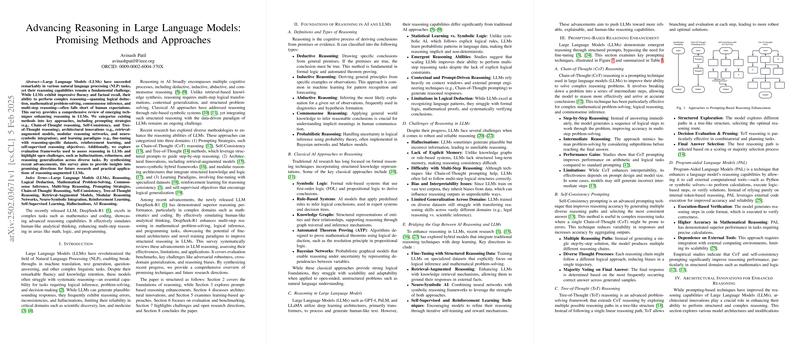The paper presents a comprehensive survey of current techniques for augmenting reasoning capabilities in LLMs (LLMs LLMs). It critically reviews three broad methodological categories: prompting strategies, architectural innovations, and learning-based approaches, with an emphasis on improving systematic reasoning—encompassing logical deduction, mathematical problem-solving, commonsense inference, and multi-step reasoning.
The discussion begins by framing reasoning as a multifaceted cognitive process that includes deductive, inductive, abductive, commonsense, and probabilistic reasoning. In contrast to classical approaches (such as symbolic logic and Bayesian networks), LLM-based reasoning is inherently implicit and grounded in statistical pattern recognition. As a consequence, the paper underscores that while scaling LLMs can lead to emergent reasoning abilities, these models still struggle with clearly defined logical inference and tend to generate incoherent intermediate steps or hallucinated facts.
Key prompting-based techniques are reviewed in detail:
- Chain-of-Thought (CoT) Reasoning:
- Decomposes complex queries into intermediate reasoning steps, improving performance in arithmetic and logical tasks.
- It is noted that while CoT offers interpretability, its success is sensitive to prompt design and model scale.
- Self-Consistency Prompting:
- Generates multiple independent reasoning chains and employs a majority voting scheme to select a final answer, thereby reducing errors that may propagate in a single chain.
- Tree-of-Thought (ToT) Reasoning:
- Extends linear CoT by exploring branching reasoning paths. This tree-structured approach allows for dynamic selection of the most promising inference routes, which is particularly valuable in combinatorial and planning contexts.
- Program-Aided LLMs (PAL):
- Integrates external computational tools (e.g., symbolic solvers or programming environments) to execute reasoning steps, yielding higher precision in computational and symbolic reasoning tasks.
Architectural innovations are discussed, particularly:
- Retrieval-Augmented Generation (RAG):
- Integrates external documents through dense retrieval (e.g., BM25 or dense passage retrieval) to ground the model's output in verifiable external data, mitigating hallucination issues.
- Neuro-Symbolic Hybrid Models:
- Fuse neural architectures with explicit symbolic logic to enhance interpretability and logical consistency by leveraging rule-based components alongside deep learning.
- Memory-Augmented Neural Networks (MANNs) and Graph Neural Networks (GNNs):
- These approaches introduce learnable external memory components or graph representations, enabling dynamic storage and retrieval that is crucial for maintaining consistency over long reasoning chains or when performing multi-hop inference.
- Tool-Use Augmentations (API Integration):
- By incorporating external APIs (e.g., for real-time computations or web searching), these models expand their reasoning range beyond the limitations of internal parametric memory.
Learning-based methods for advancing reasoning are explored as follows:
- Supervised Fine-Tuning on Reasoning-Specific Datasets:
- Datasets such as MATH, GSM8K, and LogiQA are emphasized, showcasing improvements in specialized tasks by aligning model outputs with structured logical reasoning and mathematical problem solving.
- Reinforcement Learning from Human Feedback (RLHF):
- An RLHF pipeline is presented that uses reward models and Proximal Policy Optimization (PPO) to refine reasoning. The PPO objective is defined as:
- where:
- is the probability ratio between the new and old policy at time step ,
- is the advantage estimate,
- is the clipping parameter.
This approach directly correlates with improvements in logical consistency and performance on reasoning benchmarks.
Self-Supervised and Contrastive Learning:
- Employs losses such as InfoNCE to encourage the alignment of valid reasoning pairs. An example loss is:
- where:
- represents an anchor reasoning chain,
- is a positive (correct) reasoning chain,
- is a temperature parameter,
- denotes a similarity function.
- This formulation is shown to enhance model robustness and logical generalization.
- Automated Verifiers and Critic Models:
- Secondary models are employed to verify the output of the primary reasoning process. These include formal proof checkers that validate logical inferences, addressing the issue of unverified steps in generated responses.
The evaluation section of the paper categorizes various benchmarks (e.g., ARC, LogiQA, GSM8K, MATH, BIG-Bench, HotpotQA) used to measure accuracy, logical consistency, self-consistency, adversarial robustness, and interpretability. The metrics focus not only on exact match and F1-scores but also on the explainability of intermediate reasoning steps and the calibrations of model confidence.
The paper concludes with a discussion on the persistent challenges in LLM reasoning, such as hallucinations, domain overfitting, adversarial susceptibility, and the trade-offs inherent in integrating symbolic and neural reasoning. It emphasizes the need for continued research into hybrid architectures, enhanced evaluation frameworks, and scalable verification techniques to pave the way for reasoning-augmented AI systems that are both robust and transparent.
Overall, the survey serves as an authoritative and technically detailed guide to current methods for improving reasoning in LLMs, outlining promising research directions and practical considerations for future developments in the field.
